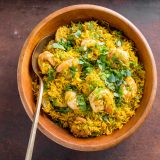With its blend of aromatic spices, layers of meat and scented rice, biryani has migrated from India around the world, picking up new names and flavorings along the way. Cashews, yogurt and peas in Myanmar’s danpauk. Lamb, saffron and dried limes in Saudi kabsa. Handfuls of dried fruit and scant bits of chicken in Afghan biryan.
In Kuwait, the shellfish of the Persian Gulf influences murabyan, which translates from Arabic to “with shrimp” and includes caramelized onions and basmati rice perfumed with up to a dozen spices. While some recipes call for parcooking ingredients separately and mixing them together for a final steam, others are unfussy, one-pot affairs, says Sarah Al-Hamad, author of “Cardamom and Lime,” a cookbook of Gulf cuisine.
“Our rice culture is very much Indian-influenced, and we use the same spices,” says Al-Hamad, a Kuwaiti-born Londoner. “At my home, we used a lot of spices, but we like to have it nicely balanced.”
At Milk Street, we couldn’t agree more, but we knew we needed to pare down the spice list without sacrificing taste. We eliminated overpowering clove, cinnamon and nutmeg in favor of cumin, cardamom, coriander, ginger, black pepper and saffron.
Our next challenge was the shrimp, which too easily turn rubbery without careful cooking. So, after coating them in some of the spice mix, we seared the shrimp on just one side before setting them aside while preparing the other ingredients. Once the rice was finished, off heat we returned the partially cooked shrimp to the covered pot to gently finish them in the rice’s residual warmth, making it impossible to overcook them.
But we did take another cue from Kuwaiti cooks, who follow the classic methodology of Indian curries to add ingredients in stages to avoid burning delicate seasonings. First, we sautéed the onions in butter until golden, scraping up the flavorful fond from parcooking the shrimp. Then we added sliced garlic along with the rest of the spices, blooming their flavors and aromas in the hot fat. The saffron and water went in next, completing an aromatic base to be absorbed by the rice as it cooked.
Lime juice and zest approximated the tart dried limes from the region while brightening the finished rice for a fragrant, complexly spiced one-pot meal.




